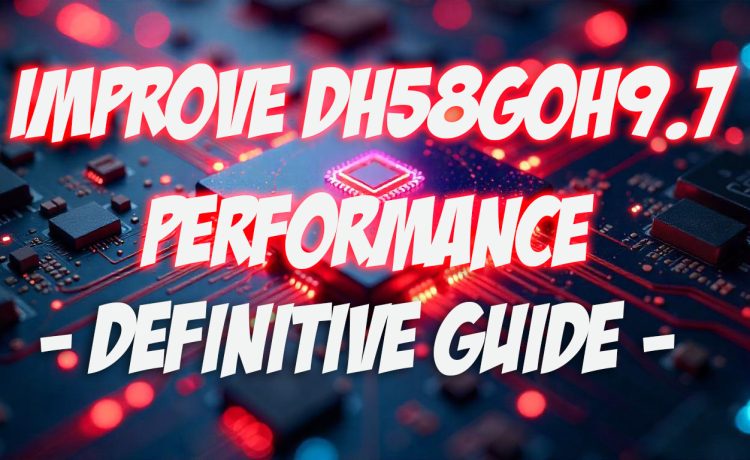The DH58GOH9.7 is a specialized device/system/component (depending on your industry, it could refer to a software module, hardware unit, or a production model). Regardless of its specific context, improving the DH58GOH9.7 model revolves around maximizing its efficiency, upgrading its features, reducing faults, and ensuring it meets evolving demands. In this comprehensive guide, we’ll break down actionable strategies to enhance the performance, reliability, and scalability of DH58GOH9.7.
Understanding DH58GOH9.7: Overview
Before attempting to improve any model or system, a deep understanding of its architecture, design, and usage is essential. DH58GOH9.7 appears to be a versioned model — likely part of a broader technological platform — suggesting that it has predecessors and may receive future updates.
Key attributes of DH58GOH9.7 might include:
- Functional complexity
- Integration with other systems
- Version-specific configurations
- Performance metrics based on user operations
Each of these factors influences how it can be improved and optimized.
1. Analyze Current Performance Metrics
Improvement begins with assessment. To improve DH58GOH9.7, start by evaluating:
- Speed and processing times
- Error rates or bug frequency
- Downtime or system interruptions
- Resource consumption (CPU, memory, bandwidth)
Using diagnostic tools or logging systems will give you real-time and historical data. Tools like Nagios, Grafana, or built-in analytics dashboards (depending on the type of system) can offer insights into bottlenecks.
2. Update Firmware/Software
For hardware-integrated or software-based DH58GOH9.7 models, running the latest firmware or software version is critical. Vendors often release patches that:
- Fix vulnerabilities
- Improve processing efficiency
- Introduce compatibility for newer integrations
Before applying updates:
- Backup current settings/configurations
- Review update notes
- Test in a controlled environment if possible
3. Optimize Configuration Settings
DH58GOH9.7 may allow for configuration customization. Depending on your objectives (speed, reliability, or security), these parameters can be adjusted:
- Cache size and refresh rate
- Timeout and retry intervals
- Resource allocation limits
- Logging verbosity levels
Misconfiguration is often a hidden performance killer. Ensuring the system aligns with your environment’s needs will dramatically improve its behavior.
4. Upgrade Hardware or Infrastructure
If the DH58GOH9.7 relies on physical hardware or is hosted on limited virtual resources, consider:

- Increasing RAM or storage
- Switching to faster SSDs
- Migrating to higher-performing cloud infrastructure (e.g., AWS EC2 with better instance types)
Bottlenecks due to inadequate resources are often misdiagnosed as software issues. Benchmark your current system to identify these limitations.
5. Enhance Security Protocols
Security improvements indirectly enhance system reliability. For the DH58GOH9.7:
- Ensure SSL/TLS encryption is enabled for all communications
- Apply the principle of least privilege (PoLP) in user permissions
- Regularly scan for vulnerabilities using tools like OWASP ZAP, Nessus, or Burp Suite
Preventing breaches and malicious interruptions protects both data and performance.
6. Enable Auto-Recovery and Failover Features
For mission-critical environments, improving uptime is key. Integrate features like:
- Auto-recovery scripts that restart failed services
- Failover mechanisms that redirect operations to backup systems
- Load balancers to distribute the workload evenly
These not only improve reliability but also ensure DH58GOH9.7 operates smoothly during peak or fault periods.
7. Train Users and Maintain Documentation
Human error accounts for many performance issues. Training users who interact with DH58GOH9.7 to follow best practices ensures optimal usage. Additionally, maintain:
- Setup documentation
- Troubleshooting guides
- Version history logs
Clear documentation helps reduce misconfiguration, improper use, or reliance on outdated practices.
8. Modular Integration and Plugin Support
If the DH58GOH9.7 is part of a modular system or supports plugins, leverage this flexibility to extend functionality:
- Add-on performance boosters or analytics modules
- Integrate with third-party monitoring tools
- Automate routine tasks via custom scripts or APIs
These integrations can streamline operations and enhance overall performance without altering core functionality.
9. Run Regular Audits and Tests
Continuous improvement demands regular review. Schedule:
- Monthly audits to check configurations
- Quarterly performance stress tests
- Security assessments every six months
This proactive approach helps you anticipate problems before they become severe.
10. Community and Vendor Support
Engage with the community or vendor that supports DH58GOH9.7. Forums, mailing lists, and official documentation often contain solutions to common issues. Benefits include:
- Learning from others’ improvements
- Accessing exclusive tools or scripts
- Faster resolution of rare bugs
If vendor support is available, consider premium packages for enterprise-level assistance.
Conclusion
Improving DH58GOH9.7 is not a one-time task, but a continuous process that involves performance evaluation, configuration refinement, security reinforcement, and infrastructure upgrades. With a strategic and systematic approach, you can significantly enhance the reliability, speed, and efficiency of this model.
Whether you’re a system administrator, developer, or IT manager, these strategies will help you maximize the potential of DH58GOH9.7 in your specific use case. Remember: the key to consistent improvement is regular monitoring, staying updated, and embracing a culture of optimization.


